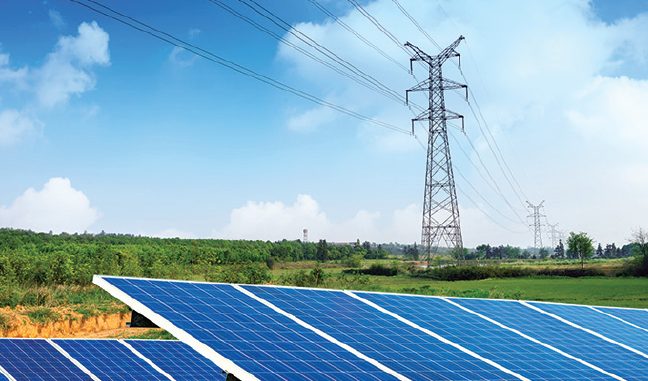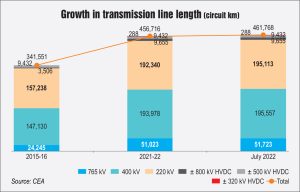
By Neha Bhatnagar
The Indian power transmission segment is set for a phase of accelerated growth, mainly driven by the need to evacuate large-scale renewables. With India targeting to meet 50 per cent of its energy needs from renewables and achieve 500 GW of non-fossil fuel capacity by 2030 as announced at COP26, significant expansion and strengthening of the interstate transmission system (ISTS) will be required.
Simultaneously, the state utilities are expected to take measures to upgrade and augment intra-state transmission as well as sub-transmission networks. In the past too, the segment has recorded significant progress in terms of physical expansion of the grid as well as in terms of technology, making the country’s electricity grid one of the largest synchronous grids in the world. As of July 2022, the total transmission line length (at the 220 kV level and above) stood at 461,768 ckt. km, the total AC substation capacity stood at 1,097 GVA and high voltage direct current (HVDC) substation capacity stood at 33,500 MW. Between 2015-16 and 2021-22, the line length has grown at a compound annual growth rate (CAGR) of nearly 5 per cent, while AC and HVDC substation capacities have grown at 8.8 per cent and 14.3 per cent respectively. The interregional transfer capacity has also grown considerably from 58,050 MW in 2015-16 to 112,250 MW in 2021-22, recording a CAGR of 15 per cent. A look at the key trends and developments in the power transmission segment…
Key developments
The government and regulators have undertaken many progressive policy and reform initiatives for the transmission segment in recent months. In July 2022, the Central Electricity Regulatory Commission (CERC) notified the Connectivity and General Network Access to the Interstate Transmission System) Regulations, 2022. This follows the power ministry’s notification on GNA in October 2021 wherein it introduced a new paradigm for transmission planning. Transition to GNA would provide the much-needed flexibility to state entities in purchasing electricity under contracts of varying durations, without the limitations of ISTS network availability. For generators too, there will be enhanced flexibility in sales as target beneficiaries will not have to be specified.
The Ministry of Power (MoP) also recently tabled the Electricity (Amendment) Bill, 2022, in Parliament, which proposes amendments to the Electricity Act, 2003. In the transmission segment, these amendments seek to strengthen the powers and functions of the National Load Despatch Centre to ensure the safety and security of the grid and for economic and efficient operation of the power system in the country. Further, the CERC is reviewing the India Electricity Grid Code (IEGC) and draft IEGC Regulations were notified recently, with a focus on long-term integrated resource planning. In addition, the Central Electricity Authority (CEA) has released a draft manual on transmission planning in light of the major changes taking place in the transmission landscape, including large-scale renewable energy integration, load growth, increased fault levels, right-of-way issues and technical advancements.
In October 2021, the prime minister’s Gati Shakti National Master Plan (NMP) was launched to address issues across infrastructure projects, including power transmission. The PM Gati Shakti NMP has a digital platform that provides a one-click comprehensive view of power transmission projects (apart from other sectors) to streamline project development, in a bid to reduce time and cost overruns. So far, all existing ISTS lines have been mapped on the portal and about 90 per cent of under-construction ISTS lines have been integrated into the portal, while 10 per cent of ISTS lines will be added after the finalisation of routes surveyed by the respective TSPs.

Key programmes and initiatives
The Green Energy Corridors (GECs), initiated in 2015, is a key programme for renewable energy evacuation in the country. Under GEC Phase I, 3,200 ckt. km of interstate transmission lines and 17,000 MVA of substation capacity have been commissioned. At the intra-state level, GEC Phase I targets an addition of 9,700 ckt. km of transmission lines and 22,600 MVA of substation capacity with completion date in 2022. Earlier this year, the central government approved the GEC Phase II programme for intra-state transmission systems. Under this phase, projects would be set up in seven states – Gujarat, Himachal Pradesh, Karnataka, Kerala, Rajasthan, Tamil Nadu and Uttar Pradesh – for evacuation of about 20 GW of renewable energy. In addition, under the Transmission Scheme for Renewable Energy Zones, evacuation infrastructure for about 66.5 GW of renewable energy capacity (50 GW solar and 16.5 GW wind) is being created, with an investment of Rs 432 billion. Another key initiative is “One Sun One World One Grid” (OSOWOG) that envisions solar energy supply across borders. Recently, on the sidelines of the COP26 summit at Glasgow in November 2021, India and the UK have agreed to combine forces of the Green Grids Initiative and the OSOWOG initiative.
TBCB update
As of August 2022, 63 ISTS projects have been bid out to public and private players since 2009. This excludes four projects that have been cancelled or are under litigation. Of the total, while 21 projects were secured by Powergrid, 42 have been won by private players. Key private players in the segment include Sterlite Power (16 projects) and Adani Transmission Limited (ATL) (14 projects).
In December 2021, ReNew Transmission Ventures Limited secured the Koppal-Narendra transmission project in Karnataka. This marked the entry of ReNew Power, a key player in the renewable energy space, in the transmission segment. The company won another project in March 2022 – Transmission Scheme for Solar Energy Zone in Gadag (2,500 MW), Karnataka-Part A – at the intra-state level and ATL bagged MP Power Transmission Package II through tariff-based competitive bidding (TBCB) in September 2021.
Cross-border interconnections
Several interconnections are planned between India and neighbouring countries, including a new 765 kV link between India and Bangladesh – the 765 kV Katihar (Bihar)-Parbotipur (Bangladesh)-Bornagar (Assam) line (initially operated at 400 kV), along with an HVDC back-to-back link at Parbotipur (2×500 MW, 1 x 500 MW at 400 kV and the second 1 x 500 MW at 765 kV). The 400 kV D/C new Gorakhpur and new Butwal transmission line is planned between India and Nepal. Further, a transmission line from the upcoming 900 MW Arun-3 hydroelectric project in Nepal is being developed by SJVN Arun-3 Power Development Company Private Limited, SJVN’s subsidiary. In addition, there are plans for the development of an overhead electricity link with Sri Lanka, after the earlier proposal to set up an undersea power transmission link was shelved due to its high cost.
Technology focus
The transmission segment is at the forefront of adopting latest technologies. The voltage level has increased from 220 kV to 765 kV, ± 800 kV HVDC and 1,200 kV and advanced technologies such as voltage source converters and FACTS (flexible AC transmission systems) are being deployed. In 2021-22, Powergrid commissioned Poles 3 and 4 of the HVDC bipole link between western region (Raigarh, Chhattisgarh) and southern region (Pugalur, Tamil Nadu) and Pugalur-Trichur 2,000 MW VSC-based HVDC system. Another technology trend in the power transmission segment is the growth in the uptake of digital switchgear and substations. Powergrid has initiated upgradation of the conventional protection and control system at the 400/220 kV old Kanpur substation to the IEC 61850 process bus-based full digital system towards digitalisation. Powergrid had earlier commissioned digital substation components at the 400/220 kV Bhiwadi substation and implemented IEC 61850 process bus technology at Malerkotla, Punjab. Remote monitoring of substations and other equipment is also gaining traction as it helps utilities reduce manual intervention. During 2021-22, 22 extra high voltage substations were integrated with Powergrid’s National Transmission Asset Monitoring Centre at Manesar, Haryana, for remote operation, taking the total remotely monitored substations to 264. Further, project developers are deploying LiDAR (light detection and ranging) technology, drones and air cranes for the construction of transmission lines and thermovision cameras and Android-based applications for operations and maintenance.
The way forward
The MoP has set targets to complete the development of 27,000 ckt. km of ISTS lines and 28 substations, with an estimated capex of Rs 700 billion under the PM Gati Shakti NMP by December 2024. So far, about one-fourth of the target has been met with the commissioning of 6,500 ckt. km of ISTS lines while the addition of about 20,500 ckt. km of lines is under way. The PM Gati Shakti initiative is expected to fast-track the development of transmission infrastructure in the country, yielding benefits for developers, generators and consumers. Overall, capital expenditure in the segment is estimated at about Rs 3,040 billion between 2020 and 2025 and the National Infrastructure Pipeline with state utilities is expected to account for a major share of 62 per cent in the capex. In addition to expanding the physical grid, the segment is expected to see the uptake of advanced technologies to improve grid capacity, resilience and stability.


